Discover the best brushes for oil painting in this guide: our top recommended brush fibres, shapes and brands compatible with the medium.
Here’s what your average paint brush looks like:

Paintbrushes specifically made for oils look a little bit different.
They often have long handles. You’ll ideally be painting on a canvas propped up vertically against an easel—your oil paint won’t flow, drip or budge from the position that you’ve placed it on the canvas (unless you’ve used a particular medium to make it extra runny)—so it makes sense to paint in this way, with your brush held horizontally. The long handles balance the brush in your hand, giving you much better control.
Handles aside, oil painting brushes come in a dizzying array of shapes, sizes, hair types and qualities.
This post is here to help you cipher through all the different types of brushes so you can understand what each one is best used for, as ultimately, the brushes you choose for oil painting will largely depend upon the effects you want to achieve in your work and the techniques you’ll be using.
I will also, as always, give some product recommendations of good quality reliable brushes that I’ve tried and tested. We all know that a good brush can be the difference between wrestling with your painting, and a tool that aids you in creating outstanding work.
Disclaimer: Fine Art Tutorials is a reader supported site. When you make purchases through links on this site, we may earn a small commission at no extra cost to you.
Brush hair types
First, I’ll give the lowdown on the different types of brush hair (otherwise known as bristles) which come in two main categories, Bristle and Sable.
Bristle
Buy bristle brushes here.
What bristle brushes are good for: blocking in shapes in your base layers, creating texture, working on rough surfaces.
All brushes have bristles, but only brushes made from hog hair (or a synthetic alternative) are actually called ‘bristle brushes’.
The bristles are stiff and hold a lot of paint. So these brushes are good if you want to create texture with your brush strokes, if you’re working on a rough surface or you want to work paint into the weave of your canvas.
The stiffness of the brush is why it’s often described as being so suited to oil painting. Oil paint straight from the tube is often pretty thick and viscous, so if you’re opting to paint without using any mediums to alter the consistency, or you’ve added a medium to make the paint thicker, bristle brushes are better to use than the softer alternative.
Bristle brushes are also used for painting base layers with and covering large sections of the canvas.
Generally the only time you would be working with bristle brushes and very fluid paint is when you’re painting base layers with oil that’s been thinned with turpentine.
Sable
Buy sable brushes for oil painting here.
What sable brushes are good for: blending colours into seamless gradients, working in ultra fine detail, creating realistic effects.
You’ve probably seen bristle brushes advertised as being for oil, and sable for watercolour, but you can use sable for oil too!
Sable brushes work beautifully with oil, in fact, most of the brushes I own are sable and I use pretty much all of them for oil painting. If a sable brush is labelled as being ‘designed for watercolour’ all that tells you is that it’s suited to paint that has very low viscosity.
You’ll know if you’ve read my post about different oil paint mediums that oil paint can be quite thick and stiff straight from the tube, but it’s easy to change the consistency of the paint to make it runnier with the addition of the right medium.
The hair of sable brushes are soft, and they shine in their ability to give the artist precise control, accuracy, and blend colours smoothly.
The disadvantage of using sable for detail in oil, is that the paint has to be fairly runny for it to work and the brushes only function properly on smoother surfaces. Sable brushes are best for small areas of delicate detail—they are a dream for realist painters.
Here are a couple of my sable rigger brushes from Da Vinci in sizes 2 and 0. As you can see, they have a nice, sharp point.

I’ve kept these brushes sharp and in good condition by cleaning them with brush soap instead of turpentine, as it’s much gentler on the fibres.
What’s a sable brush made from?
The bristles of this type of brush are most frequently obtained from a male Kolinsky, a type of Siberian weasel. The highest grade brushes will be made from hairs taken from the tail of the weasel in the winter months—it will be reddish brown in colour with a darker point. This type of bristle is considered to be the best quality by painting purists. The hairs are difficult to obtain and the brushes take time to make so they come at a fairly high price point.
Not all sable brushes are made from the weasel hair, however, you can find ones made from squirrel hair or synthetic fibres. The lower grade weasel hair, squirrel hair and synthetic hair brushes are all cheaper than the Kolinsky variety. The drawback of the squirrel hair brushes is that the fibres don’t have a ‘snap’ to them, meaning that the bristles don’t retain their sharp point when moved.
Synthetic
Synthetic bristles come in varying degrees of stiffness between hog and sable.
Some of the newer synthetic brushes are favourable to artists who want to avoid using animal based products, and will achieve similar results to the traditional natural hair brushes.
Natural hair is softer than synthetic, but it’s worth noting that the synthetic alternatives are more durable and have more of a ‘spring’, making them more suited to working with heavy bodied oil and solvent.
You will be able to find synthetic brushes that hold pigment like a hog bristle brush, are springy enough to work colour into the weave of a canvas, but soft and flexible enough to paint detail.
Here are some examples of different manufacturer’s synthetic bristles and how they behave with oil paint:
- Winsor and Newton Monarch Brush: made to mimic the properties of mongoose, this synthetic brush is both springy and soft. It can move heavy bodied oil, but paint in fine detail.
- Escoda Modernista Tadami: robust, yet soft and resistant to solvent, these brushes have flexible bristles.
- Silver Brush: Bristlon: These brushes have been designed to perform with the stiffness of hog hair, but with more durable synthetic bristles.
- Princeton Catalyst Polytip: Excellent quality brush with the stiffness of hog. These brushes hold a large volume of paint and release paint evenly and smoothly onto the surface.
- Princeton Neptune Faux Squirrel: These brushes were designed for use with watercolour, but they are one of the softest types of synthetic brush. The handles are short, but they are a vegan product. Try the round, or script liner brushes for detail work.
The advantage of choosing a synthetic brush, is that you can handpick working properties of bristle types that suit your practice.
Brush shapes and what they do

Now I’ll dig into the different brush types and functions.
Bear in mind that each different type will also have a range of sizes, there isn’t any standardised sizing, it varies from manufacturer to manufacturer—all you have to know is that the higher the number, the larger the paintbrush will be. They generally start at 20/0 (smallest) and go up to around 24+ (largest).
No matter what shape of bristle you choose, I recommend getting a few different sizes of round brushes, one larger flat tip (or wash), and a filbert. Then you can add to your collection depending on what kind of style you wish to be painting and the scale at which you will be painting.
I’m about to cover the most basic brush types, once you’ve mastered using these and you hone your painting style, you’ll naturally add more to your collection.
Round tip
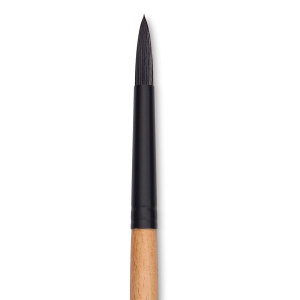
The tip of the brush tapers to a point, they are good for detailed work. You’ll probably find you’ll need a few of these, as they are incredible versatile and great for painting all manner of subjects.
Product picks
These incredible sable brushes by Da Vinci are very soft. They hold colour perfectly and are made from 100% natural hair.
This brush made by Escoda, is made from synthetic fibre. It’s springy, flexible and offers great control.
Rigger
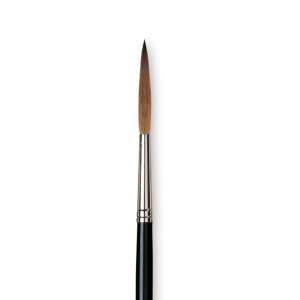
A rigger brush is recommended for highly detailed and intricate work. The long bristles create a pulled string effect. Almost like a slow drag on the movements of your hand. The bristles absorb any small hand shakes. This gives ultimate control when painting long thin lines. They’re the brush of choice for artists aiming for ultra clean and crisp detail.
The brushes taper to a point and allow the paint to run off the tip evenly. These brushes are made with sable hairs, so remember to make your paint runny like ink.
There are a number of other more specialised brushes you can get for more detailed work. I’ve outlined them in this post.
Product pick
Check out Da Vinci rigger brushes, made from sable, their ability to hold colour is really unmatchable.
Flat
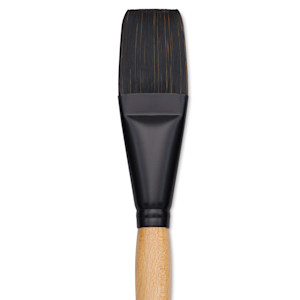
Rectangular shaped bristles can hold a lot of paint. Use them to create large washes. They are especially useful for blocking in large areas of colour in the initial stages of your painting.
Product picks
This brush by Escoda has an extra long handle. It’ features natural stiff Chungking hog hair, so it has an incredible springiness to it.
The Raphael Paris brush is made from interlocking double boiled hair, making it straight, soft but dense. It is a reasonably priced versatile brush.
Filbert
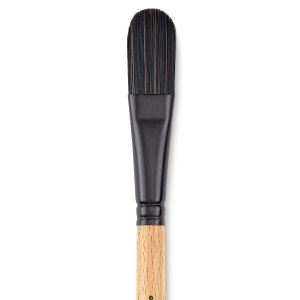
This is a very versatile brush, they come in both sable and bristle varieties. They are similar to bright brushes, but they have rounded edges, which make them perfect for blending colours. I use a range of different sized filbert brushes for blending subtle gradients in small areas of the painting.
Product pick
The Winsor and Newton Monarch filbert brush is a little stiffer than natural hair. This makes it well suited to fine detail work as well as creating colour blends in your work.
Mop brush
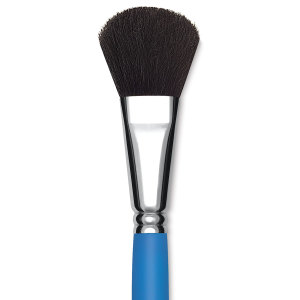
Like wash brushes, mop brushes are ideal for painting backgrounds and skies. They can also also be used to create large washes on the canvas. These brushes are often round and large in shape. This makes them ideal for blending colours together—think of blending fluffy wisps of cirrus clouds dotted across the sky.
The bristles are soft and absorbent—they soak up a lot of paint. They are softer than wash brushes, commonly made with goat hair and are round in shape.
Product pick
This goat hair mop brush stays soft and keeps its shape when wet. It’s the ultimate brush for blending and you can get it in oval or round shapes.
Bright brush
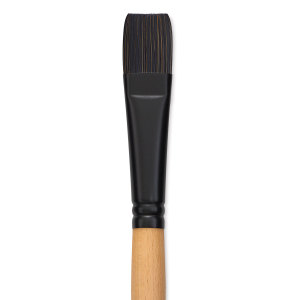
This is like a flat brush, but the bristles are shorter. These are good for short, controlled strokes and creating texture. They often have finely chiseled tips, so they are really great for creating realistic waves, ripples and other water effects.
Product pick
Monarch bright brushes have the perfect stiffness and spring to move heavy bodied oil colour. The shortness of the bristles makes it easy for the artist to create lines with sharp edges.
Fan brush

There are numerous ways to use fan brushes. You can use them to blend colours together, create multiple strokes with one stroke (this can save time if you are painting strands of grass, or trees for example), load the brush with multiple colours and blend onto the canvas.
Product pick
Winsor and Newton’s Monarch Fan brush. Synthetic mongoose hair, makes for a soft brush that’s also very durable.
Chip brush
This is the ugly duckling of the list.
I use this brush for painting base layers (i.e toning the canvas and blocking in the basic shapes). Chip brushes are large and square. They are made with hog hair as opposed to sable. As these are meant to be used for the blocking in stages, they’ll absorb a lot of solvent over time. So they’ll become dry and nasty pretty quickly. For this reason, if you decide you need one of these for your painting process, just get the cheapest one you can find.
Which chip brush is best?
Most chip brushes you find in hardware stores are fine, I get these brushes from Amazon. They’re pretty hardy brushes, and they don’t shed hairs.
Brush sets
When you’re starting out, it’s a good idea to get a set of brushes that you know will last. A good set will come with a range of sizes and brush types. So you can try each one and get to know which works best for you.
Product pick
This set of nine by Rosemary & Co has a good mix. It comes with a pointed round, two riggers, three long flat brushes, one filbert and a flat brush. See here.
Don’t throw an old brush away…
If your paintbrush looks ruined—if it’s stiff all the way through, or maybe the ends are splayed, don’t just throw it away. You can either restore it (read about how to bring your brushes back to life), or you can use the splayed ends to create some interesting textures, like the grooves on a rock or leaves on a tree. Experiment with your old brushes that have changed shape, there’s always a chance you’ll find a use for them.
Finally
If you’re just beginning on your oil painting journey and you’re not quite sure what supplies to get, start with this beginner’s guide. It’ll teach you about all the tools and materials you need to start oil painting and give you valuable advice on how to use the materials to get the best results.
Looking to stock up on oil painting supplies? Check out our shop.
Best oil painting brushes: Pin it!
If you’ve found anything on this site especially useful, you can make a donation to me through PayPal. I take a lot of time to research and write each topic, making sure each tutorial is as detailed as possible and I make all my content freely available. Any small donation (even the price of a cup of coffee!) can help me to cover the running costs of the site. Any help from my readers is much appreciated :).
Follow the link in the button below to support this site.


Instead of brush soap, I use baby oil to remove the pigment, then dish soap to remove the oil and the rest of the color, until it runs clear. Can you think of a contraindication for this cheap method? I know that baby oil is mineral, not vegetable oil, but I think the dish soap pretty thoroughly clears that out.
Baby oil and dish soap are pretty good at removing paint from brushes if you’re thorough with the cleaning. You can get budget brush soaps, which have the benefit of including extra oils in them that condition brushes and make cleaning up a little quicker, but lots of artists use the dish soap method!